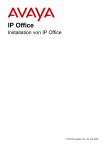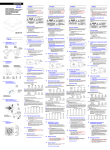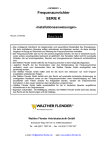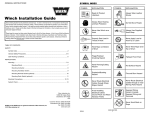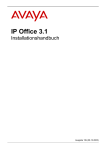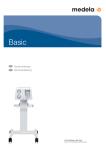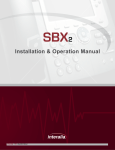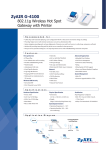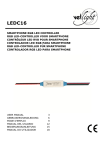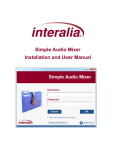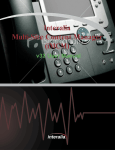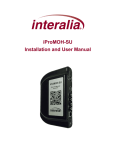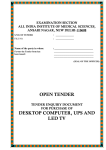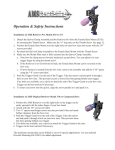Download XMU+ ATIS Guide
Transcript
Copyrights This manual and the software accompanying it are copyrighted © 2009 by Interalia Inc. ® XMU+ ATIS Guide MA18540R04E7.5 All rights reserved. No part of this book, including interior design, cover design, and icons, may be reproduced or transmitted in any form, by any means (electronic, photocopying, recording, or otherwise) without the prior written permission of Interalia Inc. Interalia Inc. Marketing Department 4110 - 79th Street N.W. Calgary, Alberta, Canada T3B 5C2 Phone: (403) 288-2706 Fax: (403) 288-5935 Interalia and the publisher have used their best efforts in preparing this book as accurately and completely as possible, however we do not make any guarantees or warranties regarding its content. Trademarks Interalia is a registered trademark of Interalia Inc. XMU+ is a registered trademark of Interalia Inc. All other product names and services identified throughout this book are used in an editorial fashion only, and for the benefit of such companies. No such use, or the use of any trade name, is intended to convey endorsement or other affiliation with the book. XMU+ ATIS Guide rev.04 Note: For the latest revision of this guide please go to http://www.interalia.com/Support/Manuals Table Of Contents Chapter 1: ATIS Overview In this chapter ... ................................................................................................................2 Automatic Terminal Information System (ATIS) ...................................................3 Overview ......................................................................................................................3 Typical ATIS Users .............................................................................................3 Cards ..............................................................................................................................3 Chapter 2: Installing the XMU+ In this chapter... .................................................................................................................6 Installation Activities .......................................................................................................7 Installing the XMU+ ATIS Unit......................................................................................8 To install an XMU+ ATIS in a rack ........................................................................8 To mount an XMU+ ATIS to a wall ......................................................................9 Checking System Startup............................................................................................ 10 Chapter 3: Cabling the XMU+ ATIS In this chapter... .............................................................................................................. 12 Cabling Activities ........................................................................................................... 13 Preparing to Cable the XMU+ ATIS ......................................................................... 14 Interface Table Conventions and Abbreviations ....................................... 14 Matching XMU+ ATIS Cables and Connectors ............................................ 15 RJ-21 50-pin Connector ....................................................................................... 16 Cabling the XMU+ ATIS Control Card .................................................................... 17 Connecting the XMU+ ATIS to a PC with XMUCOM+ Software ........... 19 To connect to the PC directly using the RS-232 port ......................... 21 To connect to the PC with an analog line to modem ........................ 21 To connect to the PC through an Ethernet (LAN) Network ............ 22 To connect to the PC directly with the Network port ....................... 22 Connecting Remote Telephone Access ........................................................ 23 To configure the Control Card for Remote Port mode ..................... 24 To connect an analog line to provide Remote Telephone Access 24 Connecting Alarms (optional) ........................................................................... 25 To wire the alarm connector ....................................................................... 26 i ii Table of Contents Alarm pin out on the XMU+ ATIS Control Card ................................... 26 Cabling XMU+ ATIS Line Cards................................................................................. 27 Wiring ......................................................................................................................... 27 Caution: ............................................................................................................... 27 1) Phantom PTT With External Voltage .................................................. 28 2) Phantom PTT With Internal Voltage ................................................... 30 3) Relay Output PTT With External Voltage .......................................... 32 4) Relay Output PTT With Internal Voltage ........................................... 34 ATIS Line card jumper positions. ............................................................... 36 XMU+ ATIS Line Card Face Plate. .............................................................. 36 Chapter 4: XMU+ ATIS Operation In this chapter... .............................................................................................................. 38 XMU+ Navigation Activities....................................................................................... 39 Node Menu Hierarchy - Single Partition Mode .................................... 39 System Menu Hierarchy - Single Partition Mode ................................ 40 Understanding the XMU+ Front Panel .................................................................. 41 Using the Front Panel .......................................................................................... 42 To record a message ...................................................................................... 43 To play a message ........................................................................................... 43 To delete a message ....................................................................................... 44 Understanding XMU+ Remote Telephone Access............................................ 45 Setting Up XMU+ Remote Telephone Access ............................................. 45 To set XMU+ Remote Telephone Access mode ................................... 46 To change the default Remote Telephone Access code .................. 46 Using Remote Telephone Access ..................................................................... 47 Remote Telephone Access Commands .................................................. 48 Working with Remote Telephone Access Messages ................................ 49 To remotely access the XMU+ .................................................................... 49 To disconnect from the XMU+ ................................................................... 49 To record a message remotely ................................................................... 50 To play a message remotely ....................................................................... 50 To delete a message remotely ................................................................... 50 To change default language of operation (optional) ........................ 51 Chapter 5: Step by Step Example In this chapter... .............................................................................................................. 53 XMU+ ATIS Configuration .......................................................................................... 54 How to guide................................................................................................................... 54 Create an ATIS Application ........................................................................................ 55 Edit and label MSG nodes ................................................................................... 56 XMU+ ATIS Guide rev.04 Create LIST Node .................................................................................................... 57 Card Configuration ................................................................................................ 58 Send the Configuration the XMU+ .................................................................. 61 ....................................................................................................................................... 62 Chapter 6: Hot Standby System In this chapter... .............................................................................................................. 63 Hot Standby System ..................................................................................................... 64 Front Panel Configuration .................................................................................. 65 Chapter 7: Standard 50-Pin Telecommunication Cable Glossary Index End User License Agreement Important Read Carefully .................................................................................... 80 Software Product License ................................................................................... 80 iii iv Table of Contents ATIS Overview Read this chapter to gain an understanding of the special applications listed below. 1 2 Chapter 1 ATIS Overview In this chapter ... Automatic Terminal Information System (ATIS) on page 3 XMU+ ATIS Guide rev.04 Automatic Terminal Information System (ATIS) Automatic Terminal Information System (ATIS) Overview Interalia’s Automatic Terminal Information System (ATIS) is a solid-state audio recording system used at airports to transmit repetitive information to arriving and departing airplanes. Pilots can receive important information even if the airport is not staffed or the personnel are busy. Information such as wind speed, air temperature, wind direction, visibility and runway conditions are typically recorded, then broadcast 24 hours-a-day to approaching or departing planes via a transmitter. Typical ATIS Users NAV CANADA US Federal Aviation Administration (FAA) US Air National Guard US Air Force Raytheon Corporation (Canada) AERONAUTICA CIVIL (Colombia) Royal Malaysian Air Force Cards The following Line Cards are available for XMU+ ATIS operation. Model 47371: 4 transmitter ports without PSTN ports. Model 47374: 4 transmitter ports with 4 PSTN ports. 3 4 Chapter 1 ATIS Overview Installing the XMU+ The installation process consists of physical installation at the appropriate location, connecting the XMU+ to its designated power supply, and checking system startup. Caution: Standard electro-static discharge (ESD) precautions must be followed when handling any internal components. Interalia cannot be held responsible for damage to parts or equipment caused by improper handling or installation. Caution: XMU+ ATIS equipment is to be installed by qualified personnel in Restricted Access Locations (RAL) where access is limited to qualified service personnel only. XMU+ ATIS Anlagen müssen von qualifiziertem Personal in zugangsbeschränkten Bereichen installiert werden, wo der Zugang auf qualifiziertes Dienstleistungspersonal beschränkt ist. Caution: When configuring jumpers on the ATIS Control Card or Line Card, the cards are to be removed from the chassis. Do not remove chassis covers and attempt to configure jumpers while the cards are operating as hazardous voltages are present inside the unit. Bei der Konfiguration der Steckbrücken auf der ATIS Steuerungs- bzw. Leitungskarte, sind die Karten von dem Platinenaufnahmerahmen zu entfernen. Da gefährliche Spannungen im Inneren der Einheit herrschen, dürfen während des Betriebs die Abdeckungen des Platinenaufnahmerahmens nicht entfernt werden und es darf nicht versucht werden, die Konfiguration der Steckbrücken vorzunehmen! Please see additional safety information on the following pages: Page 9: Installation and Power Supply Page 25: Remote Port Configuration Page 28: Line Card protective grounding and connection order Siehe auch zusätzliche Sicherheitshinweise auf folgenden Seiten: Seite 9: Installation und Stromversorgung Seite 25: Konfiguration der Fernanschlüsse Seite 28: Leitungskarte: Schutzleiter (Schutzerdung) und Verbindungsreihenfolge 2 6 Chapter 2 Installing the XMU+ In this chapter... Installation Activities on page 7. Installing the XMU+ ATIS Unit on page 8. Checking System Startup on page 10. XMU+ ATIS Guide rev.04 Installation Activities Installation Activities Complete the following activities to install the XMU+: Install XMU+ Install XMU+ Connect XMU+ to Power Supply Check System Startup 1. If required, install the XMU+ in a rack or on a wall. See To install an XMU+ ATIS in a rack on page 8 or To mount an XMU+ ATIS to a wall on page 9 for more information. 2. Connect the XMU+ ATIS to its power supply. For the large chassis, could be to one or both of the following power supplies: Note: 3. AC power. See page 18 Installation Handbook for more information. DC power. See page 18 Installation Handbook for more information. Note: Since the AC power cord is the disconnect for the XMU+, ensure that the AC receptacle is near the unit. Sicherheitshinweis: Der Netzstecker ist die An-/Ausschaltung für die XMU+. Vergewissern Sie sich deshalb, daß der Nestzanschluß in der Nähe der Maschine und leicht erreichbar ist. Check to ensure proper system startup. See Checking System Startup on page 10 for more information. 7 8 Chapter 2 Installing the XMU+ Installing the XMU+ ATIS Unit Ensure that the following tools, hardware, and accessories are near: The XMU+ ATIS unit. Mounting brackets and screws. Philips screwdriver. To install an XMU+ ATIS in a rack 1. Ensure that the mounting brackets are the correct size (19” or 23”). 2. Attach the rack mounting bracket to the XMU+ with the screws provided, as shown below: screws (4 per side) flange Small Chassis screws (4 per side) flange Large Chassis 3. Install the XMU+ in the rack using the flanges of the mounting brackets. XMU+ ATIS Guide rev.04 Installing the XMU+ ATIS Unit To mount an XMU+ ATIS to a wall 19” rack mounting brackets can be turned 90o and used to mount a large chassis XMU+ on a wall. Small chassis XMU+ units must be ordered with specific wall mounting brackets. 1. Attach the mounting brackets to the XMU+ ATIS with the screws provided, as shown below: flange screws (4 per side) 2. Note: Use appropriate screws to mount the XMU+ to a plywood backboard. Do not mount the XMU+ ATIS directly to standard wall board material. 9 10 Chapter 2 Installing the XMU+ Checking System Startup At system startup, the XMU+ ATIS identifies the current system configuration. You should watch the information displayed on the LCD to ensure that the XMU+ ATIS is working correctly. Since the system configuration information may be required at a later date for maintenance and upgrades, you should record it. To check system startup 1. Attach the XMU+ ATIS to the appropriate power supply. 2. Verify that the LCD illuminates. 3. Verify that the XMU+ ATIS identifies the current system configuration in the following order: The current firmware version installed. Proper loading of messages and prompts. The total amount of recording time currently installed. The amount of recording time that is currently available. The date and time. Cabling the XMU+ ATIS Cabling the XMU+ ATIS involves connecting and/or wiring each line card to the appropriate PBX, transmitter, or amplifier. In addition, it involves cabling the Control card to the appropriate connections, which could include: Alarm connection. Telephone lines for Remote Access and modem connections. Ethernet (network or direct) connection. Direct RS-232 connection. Caution: The cabling of the XMU+ ATIS should only be ESD Electrostatic Discharge completed by a qualified telecommunications / electronics technician. Standard static discharge precautions must be followed when handling any internal components. ESD precautions should also be observed. Interalia cannot be held responsible for damage to parts or equipment caused by improper handling or installation. 3 12 Chapter 3 Cabling the XMU+ ATIS In this chapter... Cabling Activities on page 13. Preparing to Cable the XMU+ ATIS on page 14. Cabling the XMU+ ATIS Control Card on page 17. Cabling XMU+ ATIS Line Cards on page 27. XMU+ ATIS Guide rev.04 Cabling Activities Cabling Activities Complete the following activities to connect and wire the XMU+ ATIS: 1. Ensure that the appropriate preparations are taken before cabling the XMU+. See Preparing to Cable the XMU+ ATIS on page 14. 2. Cable the Control card to the appropriate connections. See Cabling the XMU+ ATIS Control Card on page 17. 3. Connect and wire the ATIS line cards using the Cabling XMU+ ATIS Line Cards on page 27. Note: Cabling for a Master / Slave (redundancy) system is described in Hot Standby System on page 64 13 14 Chapter 3 Cabling the XMU+ ATIS Preparing to Cable the XMU+ ATIS To properly cable the various Control card connections, as well as to wire and connect XMU+ ATIS line cards, you should ensure that the following prerequisites have been met: Ensure that the appropriate cables are available for connecting and wiring the XMU+. See Matching XMU+ ATIS Cables and Connectors on page 15. As always, cables should be properly managed during XMU+ ATIS connecting and wiring, and properly stored after installation. Match the connector pinouts to specific line cards. See RJ-21 50-pin Connector on page 16. Understand the conventions used in this chapter. See Interface Table Conventions and Abbreviations on page 14. Interface Table Conventions and Abbreviations The following color abbreviations are used in the PBX interface tables. Abbreviation... Cable Color... Abbreviation... Cable Color... Blk Black Grn Green Brn Brown Blu Blue Red Red Vlt Violet Org Orange Slt Slate Yel Yellow Wht White In addition, the following conventions are used in the PBX interface tables. This Convention... Identifies... Pin The pin number on the 50 position connector. Color The wire color/stripe color for the wire corresponding to the pin on the 50 position connector. XMU+ ATIS Guide rev.04 Preparing to Cable the XMU+ ATIS Matching XMU+ ATIS Cables and Connectors Use the following table to match Control card and line card connectors to the appropriate cables and mating connectors. XMU+ Card... Connector on card... Used to... Requires connector and cable... Control Card MODEM RJ-11 connector Communicate with XMUCOM+. RJ-11 Mating Connector (telephone jack) and telephone cable. REMOTE RJ-11 connector Program messages from a remote location using a touch tone telephone. RJ-11 Mating Connector (telephone jack) and telephone cable. ALARM Alarm Connector Connect alarm circuitry. Alarm Mating Connector and ribbon cable. SERIAL-1 RS-232 connector Set up connection to XMUCOM+. RJ-45 to RJ-45 (6ft.) connector and cable and one of the following: RJ-45 to DB-25 converter. RJ-45 to DB-9 converter. SERIAL-2 RS-232 connector Perform future applications. RS-232 Mating Connector and RJ-45 to RJ-45 Ethernet cable. NETWORK RJ-45 Set up connections to XMUCOM+ software via an Ethernet network. One of the following: RJ-45 to RJ-45 (6ft.) Category 5 UTP network connector and cable for LAN connection. RJ-45 to RJ-45 crossover cable for (direct) connection. 15 16 Chapter 3 Cabling the XMU+ ATIS RJ-21 50-pin Connector Use the Amphenol RJ-21 50-pin Connector to connect the line cards to the transmitter. Each line on the Amphenol 50-pin connector has a tip (-)/ring (+) pair. The tip/ring pair provides the message audio path. Note: See Cabling XMU+ ATIS Line Cards on page 27 XMU+ ATIS Guide rev.04 Cabling the XMU+ ATIS Control Card Cabling the XMU+ ATIS Control Card The XMU+ ATIS Control card must be cabled to handle the inputs and outputs from alarms, remote access, and PC communications. The Control card has 6 connector ports, as shown below: Y X Z [ \ ] ^ _ _ This Port... Is used by XMU+ to... X MODEM Provide external (RJ-11 connector) communication with XMUCOM+ software. Y Modem Status Indicators See... To connect to the PC with an analog line to modem on page 21. The indicator displays the MODEM port status: Green - carrier detect. Yellow - transmit and receive data. Z REMOTE Program messages from a (RJ-11 connector) remote location using a touch tone telephone. Connecting Remote Telephone Access on page 23. [ ALARM (2 x 5 header connection) Connect XMU+ to alarm circuitry. Connecting Alarms (optional) on page 25. \ SERIAL-1 (RS-232 connector) Provide external communication with XMUCOM+ software. To connect to the PC directly using the RS-232 port on page 21. ] SERIAL-2 (RS-232 connector) Provide future applications. Information not yet available. ^ NETWORK Provide external (RJ-45 connector) communication with XMUCOM+ software. To connect to the PC through an Ethernet (LAN) Network on page 22. 17 18 Chapter 3 Cabling the XMU+ ATIS This Port... Is used by XMU+ to... _ Network Status Indicators The indicators display the NETWORK port status: See... Green (in connector)- link. Yellow (in connector) - activity (transmit and receive data). Green - 100 Base T (when on) and 10 Base T (when off). Yellow - collision. XMU+ ATIS Guide rev.04 Cabling the XMU+ ATIS Control Card Connecting the XMU+ ATIS to a PC with XMUCOM+ Software The XMUCOM+ software is a Windows based program that allows you to program, download, update, and backup configurations and messages to the XMU+ ATIS from a PC. See the XMU+ QuickStart Guide for more information about XMUCOM+ software and configurations. Users that have multiple XMU+ ATIS units distributed across several geographical sites must consider how to interconnect and communicate with the various units. Depending on the location, available network facilities, and modem capabilities of the XMUCOM+ system and XMU+ ATIS units, users can choose to apply a combination of one or more of the following communication methods for each of their XMU+ ATIS sites: Use... To let the XMU+ communicate with XMUCOM+... Direct Connection When the XMU+ and the PC are located within the same room. This method is effective for smaller installations, but it is not effective for organizations employing multiple XMU+ sites. Direct connections require a serial cable, and an adapter for the RJ45 connector so that it can be plugged into the PC COM port. See To connect to the PC directly using the RS-232 port on page 21 for more information. Modem Connection Through a dial-up modem connection. This method is effective for sites that are not linked through LAN/WAN networks. Modem connections require PC’s with a modem, and the modem phone numbers for the XMU + unit. See To connect to the PC with an analog line to modem on page 21 for more information. Ethernet (LAN) Connection Through LAN/WAN networks. This method is effective for organizations that have existing LAN/WAN networks operating at all XMU+ sites. Ethernet connections require: A network card to be installed within the XMUCOM+ PC. Both the PC and XMU+ unit be connected to the network for LAN access. A fixed IP address for the XMU+ unit. An IP address for the XMUCOM+ (Admin) PC. See To connect to the PC through an Ethernet (LAN) Network on page 22 for more information. 19 20 Chapter 3 Cabling the XMU+ ATIS Use... To let the XMU+ communicate with XMUCOM+... Direct Ethernet Connection With a non-LAN Ethernet connection by connecting the network port of a PC directly to the network port on the XMU+ using an RJ45 “crossover” cable. In this case, the data transfer speeds are much faster than direct connection (RS-232). Use this method if your PC is equipped with a network card, but does not have an available LAN to connect with. The cross-over cable creates a separate network connection between the PC and the XMU+ unit. Direct Ethernet connections require: A network card to be installed within the XMUCOM+ PC. A cross-over Ethernet Cable (provided by Interalia). An IP address for the XMU+ unit (default on unit is 192.168.100.2) An IP address for the XMUCOM+ (Admin) PC. See To connect to the PC directly with the Network port on page 22 for more information. The best way for XMU+ ATIS to communicate with XMUCOM+ depends on the communication systems currently available in the environment in which the XMU+ ATIS will be placed. Ideally, the XMUCOM+ software and the XMU+ ATIS unit should be installed concurrently so that full testing can be completed. See the XMU+ QuickStart Guide for more information. XMU+ ATIS Guide rev.04 Cabling the XMU+ ATIS Control Card To connect to the PC directly using the RS-232 port Direct connections require the following: Use direct connection to the RS-232 port on the XMU+ ATIS Control card when the XMU+ ATIS unit and XMUCOM+ PC are located in close proximity (the same room or desk) to each other. See Cabling the XMU+ ATIS Control Card on page 17 for more information. 1. Ensure that there is a vacant DB-25 or DB-9 port on the PC. 2. If you do not use Interalia supplied, pre-configured converters, then wire the RJ-45 connector pinouts as per the following table: XMU to PC DB-9 Female RJ45 to DB9 converter (front/rear view) RJ45 to DB25 converter (front/rear view) XMU to PC DB-25 Female RJ-45 pin 3 pin 2 TxD pin 5 Green pin 2 pin 3 RxD pin 6 Yellow pin 7 pin 4 RTS pin 7 Brown pin 8 pin 5 CTS pin 8 White pin 5 pin 7 Gnd pin 4 Red 3. Connect one end of the RJ-45 to RJ-45 cable to the RS-232 port on the XMU+. See page 10 Installation Handbook for more information about the RJ-45 to RJ45 cable. 4. Plug the free end of the RJ-45 cable into the RJ-45 end of the appropriate converter (RJ-45 to DB-25 or RJ-45 to DB-9). 5. Connect the free end of the converter to the PC’s DB9 or DB25 port. RJ-45 to RJ-45 serial cable To connect to the PC with an analog line to modem Modem connections require the following: The XMU+ ATIS provides a modem access port, which is accessed through the MODEM connector on the Control card. See Cabling the XMU+ ATIS Control Card on page 17 for more information. An analog line is connected (using a standard telephone jack and cable) to the XMU+ ATIS. 1. POTS Line POTS Plain Old Telephone Service Ensure that a vacant, active telephone outlet is nearby. If one is not nearby, install one. Always take the following safety precautions when installing or modifying telephone lines: 2. Never install wiring during a lightning storm. Never install a jack in a wet location unless the jack is specifically designed for wet locations. Never touch uninsulated wires or terminals unless the lines have been disconnected at the network interface. Connect the one end of the POTS line to the RJ-11 modem port on the XMU+. 21 22 Chapter 3 Cabling the XMU+ ATIS 3. Plug the free end of the POTS line into the vacant, active telephone outlet. To connect to the PC through an Ethernet (LAN) Network The XMU+ ATIS provides an RJ-45 port to connect to the XMU+ to a PC via a network. See Cabling the XMU+ ATIS Control Card on page 17 for more information. 1. Ensure that a vacant, active network outlet is nearby. If one is not nearby, install one. Always take the following safety precautions when installing or modifying network lines: Never install wiring during a lightning storm. Never install a jack in a wet location unless the jack is specifically designed for wet locations. Never touch uninsulated wires or terminals unless the lines have been disconnected at the network interface. 2. Connect one end of the RJ-45 to RJ-45 cable to the NETWORK RJ-45 port on the XMU+ ATIS. See page 10 Installation Handbook for more information about the RJ-45 to RJ-45 cable. 3. Plug the free end of the RJ-45 to RJ-45 cable into the vacant, active network outlet. 4. Ensure the “link” LED is on (green). To connect to the PC directly with the Network port Ethernet (direct) connections require the following: RJ-45 to RJ-45 crossover cable It is possible to create a non-LAN Ethernet connection by connecting the network port of a PC directly to the network port on the XMU+ ATIS with a crossover cable. In this case, the data transfer speeds are much faster than direct connection (RS-232). See Cabling the XMU+ ATIS Control Card on page 17 for more information. 1. Ensure that there is a vacant Network port on the PC. 2. Connect one end of the RJ-45 to RJ-45 crossover cable to the NETWORK RJ-45 port on the XMU+ ATIS. See page 10 Installation Handbook for more information about the RJ-45 to RJ-45 cable. 3. Plug the free end of the RJ-45 to RJ-45 crossover cable into the PC’s Network port. 4. Ensure the “link” LED is on (green). XMU+ ATIS Guide rev.04 Cabling the XMU+ ATIS Control Card Connecting Remote Telephone Access DTMF Dual Tone Multi Frequency The XMU+ ATIS provides a remote telephone access port, which is accessed through the REMOTE RJ-11 connector on the Control card. See Cabling the XMU+ ATIS Control Card on page 17 for more information. There are two possible modes of remote port operation: 1. PSTN Mode: An analog line is connected (using a standard telephone jack and cable) to the XMU+ ATIS remote port to provide Remote Access to the XMU+. The telephone number for that analog line must be dialed. 2. REMOTE Mode: A standard telephone set is connected to the XMU+ ATIS remote port to provide Remote Access to the XMU+. Lifting the telephone’s handset automatically connects the control card – no number has to be dialed. Remote Access connections require the following: POTS Line Either mode of Remote Access allows control of the XMU+ ATIS from a remote location using a DTMF (touch tone) telephone. Thus an operator who is not in the same room as the XMU+ ATIS, or who does not have XMUCOM+ installed on their PC, can still create and modify XMU+ messages. 23 24 Chapter 3 Cabling the XMU+ ATIS To configure the Control Card for Remote Port mode Caution: The control card is configured for PSTN or REMOTE mode of operation by moving jumpers located on headers J3 and J4 of the card’s 10636 daughter board (mounted above main board just behind face plate). Mode selection is to be done by qualified personnel only. Jumpers on J3 and J4 must be moved in tandem for continued and correct operation. The REMOTE port cable must be disconnected before changing modes with the jumpers. PSTN* (TNV)** / REMOTE Betriebsartensteckbrücken auf J3 und J4 der Platine 10636 müssen hintereinander entfernt werden, um weiterhin den ordnungsgemäßen, sicheren Betrieb zu gewährleisten. Die Betriebsartenwahl muss von Fachpersonal durchgeführt werden. Das Fernanschlusskabel muss vor dem Betriebsartenwechsel mit den Steckbrücken entfernt werden. * öffentliches gekoppeltes Telefonnetz ** Telekom-Netz-Spannung. ATIS Control Card daughterboard jumpers set for PSTN mode (for connecting REMOTE port to PSTN). Tochterplatinensteckbrücken auf der ATIS Steuerungskarte sind auf PSTNModus einzustellen (zum Anschließen des Fernanschlusses an das PSTN). ATIS Control Card daughterboard jumpers set for Remote mode (for connecting REMOTE port to standard telephone). Tochterplatinensteckbrücken auf der ATIS Steuerungskarte sind auf Fernmodus einzustellen (zum Anschließen des Fernanschlusses an das Standardtelefonnetz). To connect an analog line to provide Remote Telephone Access 1. Ensure that a vacant, active telephone outlet is nearby. If one is not nearby, install one. Prior to working with telephone lines, please refer to the following safety considerations: POTS Plain Old Telephone Service 2. Never install telephone wiring during a lightning storm. Never install a telephone jack in a wet location unless the jack is specifically designed for wet locations. Never touch uninsulated telephone wires or terminals unless the telephone line has been disconnected at the network interface. Always use caution when installing or modifying telephone lines. Connect the one end of the POTS line or analog extension to the RJ-11 remote access port on the XMU+. XMU+ ATIS Guide rev.04 Cabling the XMU+ ATIS Control Card 3. Plug the RJ-11 Mating Connector (telephone jack) on the opposite end of the POTS line or analog extension into the vacant, active telephone outlet. 4. Configure the XMU+ to allow Remote Access. See Understanding XMU+ Remote Telephone Access on page 45. Note: For a Master / Slave set-up, the Slave unit can use the same telephone line as the Master - but you must program the Slave not to answer until after 3 rings. Leave the Master unit set to answer after 1 ring. Connecting Alarms (optional) The XMU+ ATIS provides two output alarm contacts and two input alarm contacts, all of which are accessed through the contact pinout on the Control card. This alarm contact... Is used to... For more information... Output 1 Trigger an external device (a light or a buzzer) in the event of a system failure, such as input power loss or microprocessor failure. See To wire the alarm connector on page 26 for more information). Output 2 Trigger an external device or monitor in the event that one of the two power supplies fails (this feature only on an XMU+ large chassis unit with a dual power supply). See To wire the alarm connector on page 26 for more information). Input 1 Connect the optional override switch feature. When connected to the XMU+, the override switch allows regular programming to be overridden by a prerecorded message in case of an emergency. Input 2 Reserved for future use. See the XMUCOM+ application to program override messages. Information not yet available for this future feature. 25 26 Chapter 3 Cabling the XMU+ ATIS To wire the alarm connector Alarm connections require the following: When the system is powered up and running normally, there is a closed circuit between the Common (C) and the Normally Closed (NC) contacts, and an open circuit between the Common (C) and the Normally Open (NO) contacts. In an alarm condition, the opposite occurs, with an open circuit between the (C) and the (NC) contacts, and a closed circuit between the (C) and the (NO) contacts. 1. Alarm Mating Connector Wire the connector pinouts on the alarm connector using the following table. Pin... Used for... Pin... Used for... 1 Alarm 1 Output (NC). 6 Alarm 1 Input. 2 Alarm 1 Output (NO). 7 Alarm 2 Output (NC). 3 Alarm 1 Output (C). 8 Alarm 2 Output (NO). 4 Alarm 2 Input. 9 Alarm 2 Output (C). 5 Alarm 1 Input. 10 Alarm 2 Input. 2. Connect the wires to the appropriate external device, such as a light or a buzzer. 3. Plug the alarm mating connector into the ALARM port on the XMU+ control card. Alarm pin out on the XMU+ ATIS Control Card XMU+ ATIS Guide rev.04 Cabling XMU+ ATIS Line Cards Cabling XMU+ ATIS Line Cards Wiring Caution: The ATIS Line Card requires the connection of a 1.5mm 2 / 14 AWG (minimum) protective earthing (equipotential bonding / ground) conductor to the 5mm PE terminal on the card’s faceplate. This grounding arrangement must comply with local electrical code requirements. Die ATIS Leitungskarte benötigt die Verbindung eines 1,5mm 2/14 AWG (amerikanische/britische Norm für Drahtquerschnitt) (Minimum) Schutzleiters (Potenzialausgleichsleiter / Erdleiter) zu dem 5mm PE (Schutzleiter) Anschluss auf der Karten-Bedienerplatte. Die Erdungsvorrichtung muss die Voraussetzungen der örtlichen elektrischen Richtlinien erfüllen. When installing the ATIS line card, the protective earthing (equipotential bonding / ground) conductor must be connected before attaching the line interface connector which bears TNV (PSTN) circuits. Bei Installation der ATIS Leitungskarte, muss der Schutzleiter (Potenzialausgleichsleiter / Erdleiter) angeschlossen sein, bevor der Leitungsanpassungsverbinder, welcher TNV* (PSTN**) Kreisläufe trägt, anbracht wird. When removing the ATIS line card for service, the line interface connector which bears TNV (PSTN) circuits is to be removed before disconnecting the protective earthing (equipotential bonding / ground) conductor. Wenn die ATIS Leitungskarte für Wartungsarbeiten entfernt wird, muss der Leitungsanpassungsverbinder; der TNV* (PSTN**) Kreisläufe trägt, entfernt werden, bevor man den Schutzleiter (Potenzialausgleichsleiter / Erdleiter) unterbricht. * Telekom-Netz-Spannung** ˆffentliches gekoppeltes Telefonnetz 27 28 Chapter 3 Cabling the XMU+ ATIS The following tables and diagrams show how to connect the XMU+ ATIS Line Card to an air/ground transmitter. Note that there are two ATIS product options. Option 1 has a phantom PTT output, while Option 2 has a PTT relay output. Within these two options the cards can be configured, by on-board jumper settings, to either accept an external voltage or generate their own internal voltage. These jumper settings are configured to the user’s preference at the factory, or can be set / altered on site by a qualified technician. Note that lines 1 - 4 are nominally used to connect to transmitters but can be used for monitor / recorder outputs. 1) Phantom PTT With External Voltage XMU+ Signal Transmitter Ports Transmitter Signal Optional Telephone Ports TX 1 TX 2 TX 3 TX 4 Line 1 Pin/ colour Line 2 Pin/ colour Line 3 Pin/ colour Line 4 Pin/ colour Line 5 Pin/ colour Line 6 Pin/ colour Line 7 Pin/ colour Line 8 Pin/ colour Tip Transmit Audio 1 26 Wht/ Blu 29 Wht/ Brn 32 Red/ Org 35 Red/ Slt 38 Blk/ Grn 41 Yel/Blu 44 Yel/ Brn 47 Vlt/ Org Ring Transmit Audio 2 1Blu/ Wht 4Brn/ Wht 7Org/ Red 10 Slt/ Red 13 Grn/ Blk 16 Blu/Yel 19 Brn/ Yel 22 Org/ Vlt CPB PTT Volts 2Org/ Wht 5 - Slt/ Wht 8Grn/ Red 11 Blu/ Blk 55 VDC max Note: Lines 5 - 8 are optional telephone ports Jumper Name Description for 1-2 Setting Description for 2-3 Setting Value That is Set on the Card J11 Internal PTT Volts External PTT Volts 2-3 J12 Phantom PTT Separate PTT Output 1-2 J13 - Use Default Phantom Input Separate Input 2-3 J14 - Use Default High Level Input Low Level Input 2-3 XMU+ ATIS Guide rev.04 Cabling XMU+ ATIS Line Cards Jumper Name Description for 1-2 Setting Description for 2-3 Setting Value That is Set on the Card J21 Internal PTT Volts External PTT Volts 2-3 J22 Phantom PTT Separate PTT Output 1-2 J23 - Use Default Phantom Input Separate Input 2-3 J24 - Use Default High Level Input Low Level Input 2-3 J31 Internal PTT Volts External PTT Volts 2-3 J32 Phantom PTT Separate PTT Output 1-2 J41 Internal PTT Volts External PTT Volts 2-3 J42 Phantom PTT Separate PTT Output 1-2 J43 - Use Default Input Disabled Separate Input 2-3 J50 - Use Default DEFAULT DO NOT USE 1-2 J60 - Use Default DEFAULT DO NOT USE 1-2 J70 - Use Default DEFAULT DO NOT USE 1-2 J80 - Use Default DEFAULT DO NOT USE 1-2 29 30 Chapter 3 Cabling the XMU+ ATIS 2) Phantom PTT With Internal Voltage XMU+ Signal Transmitter Ports Transmitter Signal Optional Telephone Ports TX 1 TX 2 TX 3 TX 4 Line 1 Pin/ colour Line 2 Pin/ colour Line 3 Pin/ colour Line 4 Pin/ colour Line 5 Pin/ colour Line 6 Pin/ colour Line 7 Pin/ colour Line 8 Pin/ colour Tip Transmit Audio 1 26 Wht/ Blu 29 Wht/ Brn 32 Red/ Org 35 Red/ Slt 38 Blk/ Grn 41 Yel/Blu 44 Yel/ Brn 47 Vlt/ Org Ring Transmit Audio 2 1Blu/ Wht 4Brn/ Wht 7Org/ Red 10 Slt/ Red 13 Grn/ Blk 16 Blu/Yel 19 Brn/ Yel 22 Org/ Vlt Note: Lines 5 - 8 are optional telephone ports Jumper Name Description for 1-2 Setting Description for 2-3 Setting Value That is Set on the Card J11 Internal PTT Volts External PTT Volts 1-2 J12 Phantom PTT Separate PTT Output 1-2 J13 - Use Default Phantom Input Separate Input 2-3 J14 - Use Default High Level Input Low Level Input 2-3 J21 Internal PTT Volts External PTT Volts 1-2 J22 Phantom PTT Separate PTT Output 1-2 J23 - Use Default Phantom Input Separate Input 2-3 J24 - Use Default High Level Input Low Level Input 2-3 J31 Internal PTT Volts External PTT Volts 1-2 J32 Phantom PTT Separate PTT Output 1-2 J41 Internal PTT Volts External PTT Volts 1-2 J42 Phantom PTT Separate PTT Output 1-2 J43 - Use Default Input Disabled Separate Input 2-3 XMU+ ATIS Guide rev.04 Cabling XMU+ ATIS Line Cards Jumper Name Description for 1-2 Setting Description for 2-3 Setting Value That is Set on the Card J50 - Use Default DEFAULT DO NOT USE 1-2 J60 - Use Default DEFAULT DO NOT USE 1-2 J70 - Use Default DEFAULT DO NOT USE 1-2 J80 - Use Default DEFAULT DO NOT USE 1-2 31 32 Chapter 3 Cabling the XMU+ ATIS 3) Relay Output PTT With External Voltage XMU+ Signal Transmitter Signal Transmitter Ports Optional Telephone Ports TX 1 TX 2 TX 3 TX 4 Line 1 Pin/ colour Line 2 Pin/ colour Line 3 Pin/ colour Line 4 Pin/ colour Line 5 Pin/ colour Line 6 Pin/ colour Line 7 Pin/ colour Line 8 Pin/ colour Tip Transmit Audio 1 26 Wht/ Blu 29 Wht/ Brn 32 Red/ Org 35 Red/Slt 38 Blk/Grn 41 - Yel/ Blu 44 - Yel/ Brn 47 - Vlt/ Org Ring Transmit Audio 2 1 - Blu/ Wht 4 - Brn/ Wht 7 - Org/ Red 10 - Slt/ Red 13 Grn/Blk 16 Blu/Yel 19 Brn/Yel 22 Org/Vlt CPA PTT 27 Wht/ Org 30 Wht/ Slt 33 Red/ Grn 36 Blk/ Blu CPB PTT Volts 55 VDC max 2 - Org/ Wht 5 - Slt/ Wht 8 - Grn/ Red 11 Blu/Blk Note: Lines 5 - 8 are optional telephone ports. PTT output from CP1 pin can be used directly if transmitter type permits and phantom PTT is not required. Jumper Name Description for 1-2 Setting Description for 2-3 Setting Value That is Set on the Card J11 Internal PTT Volts External PTT Volts 2-3 J12 Phantom PTT Separate PTT Output 2-3 J13 - Use Default Phantom Input Separate Input 2-3 J14 - Use Default High Level Input Low Level Input 2-3 J21 Internal PTT Volts External PTT Volts 2-3 J22 Phantom PTT Separate PTT Output 2-3 J23 - Use Default Phantom Input Separate Input 2-3 J24 - Use Default High Level Input Low Level Input 2-3 J31 Internal PTT Volts External PTT Volts 2-3 J32 Phantom PTT Separate PTT Output 2-3 XMU+ ATIS Guide rev.04 Cabling XMU+ ATIS Line Cards Jumper Name Description for 1-2 Setting Description for 2-3 Setting Value That is Set on the Card J41 Internal PTT Volts External PTT Volts 2-3 J42 Phantom PTT Separate PTT Output 2-3 J43 - Use Default Input Disabled Separate Input 2-3 J50 - Use Default DEFAULT DO NOT USE 1-2 J60 - Use Default DEFAULT DO NOT USE 1-2 J70 - Use Default DEFAULT DO NOT USE 1-2 J80 - Use Default DEFAULT DO NOT USE 1-2 33 34 Chapter 3 Cabling the XMU+ ATIS 4) Relay Output PTT With Internal Voltage XMU+ Signal Transmitter Signal Transmitter Ports Optional Telephone Ports TX 1 TX 2 TX 3 TX 4 Line 1 Pin/ colour Line 2 Pin/ colour Line 3 Pin/ colour Line 4 Pin/ colour Line 5 Pin/ colour Line 6 Pin/ colour Line 7 Pin/ colour Line 8 Pin/ colour Tip Transmit Audio 1 26 Wht/ Blu 29 Wht/ Brn 32 Red/ Org 35 Red/Slt 38 Blk/Grn 41 - Yel/ Blu 44 - Yel/ Brn 47 - Vlt/ Org Ring Transmit Audio 2 1 - Blu/ Wht 4 - Brn/ Wht 7 - Org/ Red 10 - Slt/ Red 13 Grn/Blk 16 Blu/Yel 19 Brn/Yel 22 Org/Vlt CPA PTT 27 Wht/ Org 30 Wht/ Slt 33 Red/ Grn 36 Blk/ Blu Note: Lines 5 - 8 are optional telephone ports. PTT output from CP1 pin can be used directly if transmitter type permits and phantom PTT is not required. Jumper Name Description for 1-2 Setting Description for 2-3 Setting Value That is Set on the Card J11 Internal PTT Volts External PTT Volts 1-2 J12 Phantom PTT Separate PTT Output 2-3 J13 - Use Default Phantom Input Separate Input 2-3 J14 - Use Default High Level Input Low Level Input 2-3 J21 Internal PTT Volts External PTT Volts 1-2 J22 Phantom PTT Separate PTT Output 2-3 J23 - Use Default Phantom Input Separate Input 2-3 J24 - Use Default High Level Input Low Level Input 2-3 J31 Internal PTT Volts External PTT Volts 1-2 J32 Phantom PTT Separate PTT Output 2-3 J41 Internal PTT Volts External PTT Volts 1-2 XMU+ ATIS Guide rev.04 Cabling XMU+ ATIS Line Cards Jumper Name Description for 1-2 Setting Description for 2-3 Setting Value That is Set on the Card J42 Phantom PTT Separate PTT Output 2-3 J43 - Use Default Input Disabled Separate Input 2-3 J50 - Use Default DEFAULT DO NOT USE 1-2 J60 - Use Default DEFAULT DO NOT USE 1-2 J70 - Use Default DEFAULT DO NOT USE 1-2 J80 - Use Default DEFAULT DO NOT USE 1-2 35 36 Chapter 3 Cabling the XMU+ ATIS ATIS Line card jumper positions. XMU+ ATIS Line Card Face Plate. The front of the ATIS line card has a standard Amphenol 50 pin connector (we recommend using a C157-32500 Amphenol with this connector) and four (4) output potentiometers. These ‘pots’ are used to adjust the transmitter output level from 10dBm to +2dBm depending on the user’s requirements. The internal PTT generator status LED should be on and green to confirm the internal 24v source is available and working. XMU+ ATIS Operation In order to properly test XMU+ ATIS installation, you must understand the options XMU+ ATIS offers for navigation and configuration, including: The XMU+ Front Panel. See Understanding the XMU+ Front Panel on page 41. XMUCOM+ software. See the XMU+ QuickStart Guide. Remote XMU+ ATIS access. See Understanding XMU+ Remote Telephone Access on page 45 and Using Remote Telephone Access on page 47. As well, you should gain a brief understanding of the XMU+ ATIS firmware hierarchy in order to easily navigate through the XMU+ Front Panel. Firmware is the software that is hard-coded into the XMU+ Control card and the various line cards. See Node Menu Hierarchy - Single Partition Mode on page 39. 4 38 Chapter 4 XMU+ ATIS Operation In this chapter... XMU+ Navigation Activities on page 39. Node Menu Hierarchy - Single Partition Mode on page 39. Understanding the XMU+ Front Panel on page 41. Understanding XMU+ Remote Telephone Access on page 45. XMU+ ATIS Guide rev.04 XMU+ Navigation Activities XMU+ Navigation Activities Complete the following activities to understand XMU+ navigation and to prepare for setting up configurations: Understanding XMU+ Navigation Understand Firmware Hierarchy Understand Front Panel Navigation Using the Front Panel Understand Remote Access Navigation Configuring and Using Remote Access 1. Understand the XMU+ hierarchy. See Node Menu Hierarchy - Single Partition Mode on page 39 for more information. 2. Understand Front Panel navigation, and learn to configure the XMU+ using the Front Panel. See the following for more information: 3. Understanding the XMU+ Front Panel on page 41. Using the Front Panel on page 42 If required, configure the XMU+ to allow Remote Access and learn to navigate using Remote Access. See the following for more information Understanding XMU+ Remote Telephone Access on page 45. Using Remote Telephone Access on page 47. Node Menu Hierarchy - Single Partition Mode XMU+ configurations control the behavior and functionality of XMU+. Nodes are used to program and define these configuration files. Users can view information about each node by navigating through the node menu hierarchy. See XMU+ QuickStart Guide for more information about nodes. 39 40 Chapter 4 XMU+ ATIS Operation The following configuration structure represents the Front Panel node menu for the XMU+: System Menu Hierarchy - Single Partition Mode XMU+ system access codes, communication protocols, and system details and status can all be viewed by navigating through the card menu hierarchy on the Front Panel. However, XMUCOM+ also provides an easy-to-use interface for setting, changing, and viewing these parameters. See XMU+ QuickStart Guide for more information about system configuration. The following configuration structure represents the Front Panel system menu when the XMU+ is operating in Single Partition mode: XMU+ ATIS Guide rev.04 Understanding the XMU+ Front Panel Understanding the XMU+ Front Panel The XMU+ can be configured by using the four buttons and the LCD located on the Front Panel, as shown below. The Front Panel buttons are used to navigate through the XMU+ configuration menu that is shown on the LCD (display). The menu is arranged in a top-down flow. [ Y Y X Z This feature... Is used to... X 2 x 16 LCD character display Display function information and line status to the user. Y Arrows Navigate to the various XMU+ menu options. Z Enter Select a menu option or to navigate to a deeper level of the menu. [ Exit Navigate back up the menu. Note: XMU+ can also be managed and configured with XMUCOM+ software. This software provides an intuitive, easy-to-use interface for designing and changing XMU+ configurations, and for completing XMU+ administrative functions. See the XMU+ QuickStart Guide for more information. 41 42 Chapter 4 XMU+ ATIS Operation Using the Front Panel The LCD (display) shows two 16-digit lines. The top line of the display shows the main program category, while the bottom line shows one of the possible selections in that category. An arrow (< or >) on the left or right edge of the display indicates that there is another possible selection in the direction shown. For example, you are configuring message # 1 if you see the display to the right: You have the following options in this case: 1. Access additional selections by pressing the right arrow button. There are no selections available by pressing the left arrow button. 2. Select the option that appears on the display (Play) by pressing the Enter button. 3. Exit this display by pressing the Exit button. Certain menu items require the selection of a number, for example message index number, as shown in the display to the right: You have the following options in this case: 1. Press the right arrow key to display the next message number. 2. Press the left arrow key to display the previous message number. 3. Press enter to select the current message. XMU+ ATIS Guide rev.04 Understanding the XMU+ Front Panel To record a message 1. Connect a handset (included with the XMU+) or tapedeck to the XMU+ unit. 2. Press Enter to access the Main Menu. 3. Press Enter to select Messages. 4. Press the Right Arrow button until you reach the desired message number and press Enter. TIP... 5. Press the Right Arrow button until you reach Record and press Enter. To pause while recording, press Enter. To resume recording, press Enter again. 6. Press Enter (again) to begin recording your message. XMU+ monitors your recording time. 7. Press Exit to stop recording. 8. Press Right Arrow to reach Replace and press Enter. 9. Press Exit until the menu returns to the main display. To play a message TIP... To pause while playing, press Enter. To resume playing, press Enter again. 1. Connect a handset (included with the XMU+) to the XMU+ unit. 2. Press Enter to access the Main Menu. 3. Press Enter to select Messages. 4. Press the Right Arrow button until you reach the desired message number and press Enter. 5. Press Enter to select Play on the menu. 6. Press the Left Arrow for “Standby MSG” or Right Arrow for “Selected MSG.” 7. Press Enter (again) to play the message. XMU+ plays the message, counting-down the remaining playing time of the message. 8. Press Exit to stop playing (or allow the message to play itself out). 9. Press Exit until the menu returns to the main display. 43 44 Chapter 4 XMU+ ATIS Operation To delete a message 1. Press Enter to access the Main Menu. 2. Press Enter to select Messages. Y 3. Press the Right Arrow button until you reach the desired message number and press Enter. Z 4. Press the Right Arrow button until you reach Delete and press Enter. XMU+ displays a message asking if you are sure that you want to delete this message. [ 5. Press Enter to delete the message. \ 6. When XMU+ re-displays Message # <Delete>, press Exit until the menu returns to the main display. XMU+ ATIS Guide rev.04 Understanding XMU+ Remote Telephone Access Understanding XMU+ Remote Telephone Access The Remote Access feature allows a programmer to access XMU+ from a remote location using a touch-tone telephone. The XMU+ ATIS Control Card can be configured for remote access through the telephone network (PSTN mode) or through direct connection to a standard telephone (Remote mode). For either of these modes operation is the same. When the programmer presses the touch-tone keys, the XMU+ receives a DTMF tone and responds with voice prompts that instruct the programmer on how to proceed. When a user accesses the XMU+ remotely, the XMU+ responds immediately with a request for an access code. The manner in which the XMU+ responds from that point on depends on the access code entered. Entering this Allows... access code... Specifications... System Administrators access to all levels of XMU+ features and options. This number is unique from all other XMU+ access codes. Message Users access to specific messages in the XMU+. A message access code only allows changes to messages with that access code assigned to it. This code can be shared by one or more messages. Message access codes cannot Each message in the XMU+ can be assigned an be the same as the access code. If the user enters a message specific System access codes. access code via remote access, then they do not have to enter the message number and # when using the record, play, or replace functions. Setting Up XMU+ Remote Telephone Access If Remote Access will be used to communicate with the XMU+, the unit must be: 1. Cabled to a telephone line. 2. Set XMU+ to Remote Access mode using the XMU+ Front Panel. See To set XMU+ Remote Telephone Access mode on page 46. 3. Programmed with a Remote Access code using the XMU+ Front Panel. (optional). See To change the default Remote Telephone Access code on page 46. Note: Remote telephone access can also be used with a ‘Ring Down’ circuit 45 46 Chapter 4 XMU+ ATIS Operation To set XMU+ Remote Telephone Access mode Remote access mode is set to Ring Start (R) by default, and is rarely changed. 1. Press Enter to access the Main Menu. 2. Press the Right Arrow (three times) until you reach System on the Main Menu, and press Enter. 3. Press the Right Arrow until you reach Remote Mode, and press Enter. 4. Press the Right Arrow until you reach the desired remote mode, and press Enter. You can choose from the following options: 5. Y Z [ R - Ring start with loop/shunt disconnect (default). RD - Ring start with DTMF disconnect. RB - Ring start with busy tone disconnect. RT - Ring start with dial tone disconnect. RQ - Ring start with quick answer. Press Exit until the menu returns to the main display. To change the default Remote Telephone Access code Assigning a new, unique access code to each XMU+ is recommended to prevent unauthorized telephone access to your system. If multi-partitioning is enabled, a unique Remote Access code is required for each partition in addition to the System code. See on page 44 and the XMU+ QuickStart Guide for more information about multiple access codes. 1. Press Enter to access the Main Menu. 2. Press the Right Arrow (three times) until you reach System on the Main Menu, and press Enter. 3. Hit the right arrow key and Enter to select Access Codes. 4. Press Enter to select Remote Access. 5. Press Enter to select the first digit in the existing access code. 6. Use the Right Arrow or Left Arrow to select a new Remote Access code digit, and press Enter. 7. Repeat Step 6 until the new access code is entered. Access codes must have a minimum of 4 and a maximum of 8 digits. 8. Press Exit until the menu returns to the main display. Y Z [ \ XMU+ ATIS Guide rev.04 Understanding XMU+ Remote Telephone Access Using Remote Telephone Access There are many reasons to use Remote Telephone Access on the XMU+, including: Ease of use by users who are accustomed to making touch-tone keypad commands. Crisp, clear messages, since the background noise from other equipment in a COMS room is eliminated. Access to the XMU+ from any location. Every remote access session starts with the user entering a Remote Access security code. See Understanding XMU+ Remote Telephone Access on page 45 for more information about Remote Telephone Access codes. Once the code has been verified by XMU+, the various activities listed on the next page can be completed by entering the appropriate remote telephone access command. There are two ways to enter remote telephone access commands Interactive and Direct. With this Type of Command... The user enters... For example, to play a message... Interactive A single digit command, immediately followed by #. Enter 8#. The XMU+ then prompts Enter Message Number. Pressing # indicates the end of a command to the XMU+. If required, the system then prompts the user to the next step or option, where they again enter the command and #. Direct Note: Enter the nnn # (where nnn is the message number). The XMU+ then prompts the user to the next step or option. The XMU+ will give the user 10 seconds to enter the message number. A multi-level command, immediately followed by #. Enter 8 nnn # (where nnn is the message number.) The direct entry method allows advanced users to enter commands quickly, without waiting for a prompt from the XMU+. Pressing # indicates the end of a command to the XMU+. The XMU+ then prompts the user to the next step or option. Once a digit is pressed, additional digits must be entered within 2 seconds, or the XMU+ will automatically terminate the entry. Pressing # at any time during an entry will terminate the entry. 47 48 Chapter 4 XMU+ ATIS Operation Remote Telephone Access Commands This table outlines the different functions that can be executed on the XMU+ ATIS using the Remote Access Port on the control card. TIP... To cancel the delete command and return to the previous menu, press Exit when XMU+ asks Are you sure?. Command Remote Access Protocol Change access code for message # xxx 1xxx# Change system access code 10# Change language prompt to English 401# Change language prompt to French 402# Change language prompt to Spanish 403# Change language prompt to German 404# Change language prompt to Portuguese 405# Get unit type / S/W version 499# Monitor Transmitter (Card / Line) 68xy# Record Message #xxx 7xxx# Play Message #xxx 8xxx# Replace Message #xxx (with message #0) 9xxx# Disconnect 0# Terminate / Restart (ask for new password) 000 (Remote Telephone Access only) Note: nnn = partition, message, or access code number x = card number, y = line number, z = language number * = only available with partitioning enabled ** = only available with partitioning disabled + = Message number ‘0’ is a temporary message (Standby Message), which can be recorded and played without affecting any other messages. When the user decides that the temporary message is recorded properly, they can replace any message in the XMU+ with the temporary message. When the user disconnects, the temporary message is automatically erased. XMU+ ATIS Guide rev.04 Understanding XMU+ Remote Telephone Access Working with Remote Telephone Access Messages Users wanting to add, remove, or change a message remotely must have a good understanding of the configuration and messages in the XMU+. The user must also know the message number associated with each message they want to work with. This information is collected during configuration design and implementation. See the XMU+ QuickStart Guide for more information about messages. To remotely access the XMU+ 1. Dial the Remote Access telephone number, or lift the handset on a ring down circuit. When the XMU+ answers the line, it responds Enter Access Code. 2. Enter the appropriate Remote Access code, followed by #. The access code entered determines the functions and options that the user is allowed access to. See Understanding XMU+ Remote Telephone Access on page 45. The XMU+ responds Enter Command. 3. Enter the command number (see Remote Telephone Access Commands on page 48), and follow the XMU+ responses until the desired command has been completed. Note: If an invalid command or message number is selected, the XMU+ responds with the following message: Error - Invalid Command or Error - No or Invalid Message. To disconnect from the XMU+ 1. Complete the command. 2. Press 0, followed by #. The XMU+ responds Done, and disconnects the line. Note: If a remote command is not received within 30 seconds, the XMU+ automatically disconnects from the line. 49 50 Chapter 4 XMU+ ATIS Operation To record a message remotely 1. Determine the number of the message you want to record. 2. Remotely access the XMU+. See Working with Remote Telephone Access Messages on page 49 for more information. 3. When the XMU+ responds Enter Command, press 7. 4. Press the message number (nnn) you want to record, followed by #. 5. When the XMU+ responds with a short beep, record the message. 6. Press # to stop recording. The XMU+ responds with Message ‘nnn’ recorded. To play a message remotely 1. Determine the number of the message you want to play. 2. Remotely access the XMU+. See Working with Remote Telephone Access Messages on page 49 for more information. 3. When the XMU+ responds Enter Command, press 8. 4. Press the message number (nnn) you want to play, followed by #. XMU+ plays the message. 5. Press # to stop playing the message. To delete a message remotely 1. Determine the number of the message you want to delete. TIP... 2. To cancel the delete command, hang up before you reach Step 3. Remotely access the XMU+. See Working with Remote Telephone Access Messages on page 49 for more information. 3. When the XMU+ responds Enter Command, press 39. 4. Press the message number (nnn) you want to delete, followed by #. 5. The XMU+ will respond with a verbal confirmation ‘done’. XMU+ ATIS Guide rev.04 Understanding XMU+ Remote Telephone Access To change default language of operation (optional) When the XMU+ is accessed remotely, the first response it gives is always in English (Enter Access Code). The language it responds with from that point is also English, unless the language of operation is changed to French, Spanish, German, or Portuguese. With single or multi-partitioned XMU+ units, each partition can be programmed to respond with a different language. 1. Remotely access the XMU+. See Working with Remote Telephone Access Messages on page 49 for more information. 2. When the XMU+ responds Enter Command, press 4. 3. Press the number for the language you want to use, followed by #: Press 1 # for English (default). Press 2 # for French. Press 3 # for Spanish. Press 4 # for German. Press 5 # for Portuguese. The XMU+ will now use the selected language as its default language of operation for Remote Access. 51 52 Chapter 4 XMU+ ATIS Operation Step by Step Example In this chapter... Create an ATIS Application on page 55 Card Configuration on page 58 Send the Configuration the XMU+ on page 61 5 54 Chapter 5 Step by Step Example XMU+ ATIS Configuration How to guide..... This chapter is to aid in your understanding of how to set up an ATIS application on your XMU+ unit using XMUCOM+ administration software. Full XMU+ instructional manuals can be found on the CD included in your shipment. The following is a step by step guide to creating an ATIS configuration using XMUCOM+ software, then transferring that configuration to the XMU+ unit. Suggested message script for this ATIS example:Msg1 - ATIS message in English. Msg2 - ATIS message in second language e.g. Spanish. Msg3 - Other messages (if applicable.) XMU+ ATIS Guide rev.04 Create an ATIS Application Create an ATIS Application First double click the XMUCOM+ icon on you desktop or select XMUCOM+ from your Windows Start menu. Then click File, New Tool bar Displays nodes as you create them. Click to view details in the other pane, or double click to edit. View node details in this pane This window is divided into two large panes and a tool bar. The tool bar across the top has a number of buttons (MSG, CMD, LIST etc.) which are referred to as ‘nodes.’ The nodes are used in various combinations to create a ‘configuration.’ The configuration is sent to the XMU+ along with audio files (.wav files) and is the program that instructs the XMU+ how to behave. To create a node for the configuration you simply click on the relevant button in the tool bar and the node will appear in the left hand pane. The details of that node will appear in the right hand pane. When you have multiple nodes in the left hand pane, you can click on any one to view its details in the right hand pane, or double click on one to edit those details. First we need to create and label the messages used by the ATIS application. Click the MSG button in the Config Builder window three (3) times to create three Message nodes. Double click on MSG node one (1) in the upper left hand pane to open the MSG Node Editor window and edit the attributes of that message. Use the scroll buttons at the top of the MSG node editor window to edit MSG nodes two and three. Msg 1 - ATIS message in English Msg 2 - ATIS message in Spanish Msg 3 - Other message if applicable 55 56 Chapter 5 Step by Step Example Edit and label MSG nodes Next we’ll ‘map’ the message nodes to the audio files which should be stored on your hard drive or network. To do this simply click on the box to the right of the “File Name” field in the MSG Node Editor window, then browse to where the audio file for the message is stored. Select the .wav file and click ‘open.’ Note: If you do not have the audio files on your computer, you can record the messages directly onto the XMU+ via the remote telephone access port or using Message Manager. You can also use the handset & front panel. Once you have edited the MSG nodes, your Config Builder window should look like this. XMU+ ATIS Guide rev.04 Create an ATIS Application Create LIST Node In an ATIS application we require a LIST node into which the MSG nodes will be referenced. Click on the LIST button in the Config Builder window and create a LIST node, then double click on that node to edit it. The following three screenshots show a LIST node which contain a single message, dual language messages, and multiple messages. Use whichever one is suitable for your application. LIST node with single message. LIST node with dual language message. LIST node with dual language message. Note: To add messages to the LIST node, click on the ‘add’ button, then click the ‘edit’ button to change it to MSG 2, MSG 3, etc. The label field will automatically complete with the same label you gave to the MSG node - after you have saved your changes. 57 58 Chapter 5 Step by Step Example Card Configuration Now we have created the configuration, we need to tell the XMU+ which of its line cards and which ports on that line card to run this configuration on. Here we are going to use Card one, ports 1 through 8. In the menu bar at the top of your screen, click on Configuration, Card Configuration. The following window will open. Next double-click on Card One to open the Card Editor window. Select ‘ATIS’ from the drop down box in the top left hand corner, then configure this window as shown in the screen-shot below. XMU+ ATIS Guide rev.04 Create an ATIS Application The following screen-shot is just an example to show how you’d configure this window if you wanted to play messages to two transmitters. You would of course also have to add the second LIST node and applicable messages to the configuration. This screen-shot shows an example of how to configure this window if you also wanted to connect telephones lines to the XMU+ so that callers could also hear the ATIS messages. Note: If the Config Builder window should disappear from view, simply click on the Configuration Builder button near the top of your XMUCOM+ window. 59 60 Chapter 5 Step by Step Example We have now created all the nodes and your config builder should look like this. The configuration is complete. The Config Builder window displays all the nodes we have created, their labels if we entered them, and the details of the highlighted nodes in the right hand pane of this window. If you highlight a MSG node you can listen to the audio file by clicking on the green button in the tool bar. This is a ‘play’ button. XMU+ ATIS Guide rev.04 Create an ATIS Application Send the Configuration the XMU+ All that’s left is to send the configuration and the messages to the XMU+. First save the configuration on your hard drive or network using File, Save as. Now from the menu bar at the top of your XMUCOM+ screen, click on Communication, Communicate. The following window will open. In the screen shot above you can see we have selected “Send entire Configuration.” Next we need to tell XMUCOM+ where to send it. Click on the “Step 2: Site/Schedule” tab to show the following screen. 61 62 Chapter 5 Step by Step Example Next highlight the site you wish to send the configuration to by clicking on it. Then click the add button. Now click the Apply button and XMUCOM+ will send the configuration to the selected XMU+ site. Finally you’ll need to repeat the last two steps, but instead of “Send Entire Configuration,” you now need to select “Send All Messages.” Note: To add ‘sites’ to your site book, click on Communicate, Site Book. In the window that opens, click ‘New’ and enter the relevant information. Your XMU+ is now configured for ATIS operation. Hot Standby System In this chapter... Hot Standby System on page 64 6 64 Chapter 6 Hot Standby System Hot Standby System If the broadcast messages are deemed ‘critical’ the XMU+ ATIS can have a ‘hot’ standby, or redundant system ready to automatically changeover to in the event of a failure on the master system. This section describes the ATIS standby operation on XMU+ transmitter channels. The standby operation allows two XMU+ units to be configured as a master / slave pair such that if the master unit fails, the slave will resume operation. In addition, any messages that are updated on the master unit will automatically be transferred to the slave unit so that the messages are always synchronized. Setup The system is typically setup as shown below. There are two XMU+s configured as a pair with one designated as the master and one designated as the slave. Communication between the units is accomplished via a crossover Ethernet cable and a crossover serial cable. Each unit is given a distinct IP address and is programmed with the address of the corresponding unit. The backup link is enabled (over the serial link) in case the primary Ethernet link ever fails. Slave XMU+ Master XMU+ Ethernet Ethernet Serial-2 Serial-2 Communications Setting IP Address = 192.168.1.2 IP Netmask = 255.255.255.0 IP Gateway = 192.168.1.1 IP Address = 192.168.1.3 IP Netmask = 255.255.255.0 IP Gateway = 192.168.1.1 Standby Settings Standby Mode = Master Standby Partition = 1 Remote IP Address = 192.168.1.3 Backup Link = Enabled Standby Mode = Slave Standby Partition = 1 Remote IP Address = 192.168.1.2 Backup Link = Enabled XMU+ ATIS Guide rev.04 Hot Standby System If the Ethernet port is also required for XMUCOM+ access, the Ethernet crossover cable may be replaced by a standard Ethernet hub or switch. The network administrator must assign unique static IP addresses to each of the units (DHCP is not supported). There are four configurable parameters for standby operation namely standby mode, partition, remote IP address, and backup link. The meaning of each of these parameters is shown below. Standby Mode - The mode determines what role this unit will play in the master / slave pair. When the mode is set to “Disabled”, the unit acts as standalone XMU+ (normal operation). This is the default mode of operation for all XMU+s. To enable standby operation, change the mode to Master or Slave. Partition - Select the partition which will be synchronized. By default, the XMU+ has only one partition and that partition is 1. If multiple partitions are enabled, choose which partition to use. Remote IP Address - This should be set to the IP address of the other unit in the pair. Backup Link - If a secondary communications link is required for additional redundancy between the pair, a serial crossover cable may be added between the units. Set this option to “Enabled” if this is required. Front Panel Configuration The configuration for standby operation is contained in the system menu of the front panel. The menu tree for standby configuration is: 65 66 Chapter 6 Hot Standby System Normal Operation Booting: In order to boot the system, turn on the master and the slave at the same time. If the units are booted more than 60 seconds apart, a failure will be detected during boot. To avoid this failure from occurring, start the units at the same time. The units will automatically synchronize all of their messages during boot. Updating Messages: All message updates should be done on the master unit. This applies to front panel, remote, and XMUCOM+ message downloads. When the master unit receives a new message, it automatically updates the same message on the slave unit. It is important to note that a message recorded on the slave will NOT be transferred to the master (see exception below in Master Failure). Failure Operation and Recovery Master failure: In the event that the master unit fails, the slave unit becomes active. The slave unit will be fully functional including the ability to record new messages. When the master unit is repaired and brought back into service, the master will download all of the latest messages from the slave. When the synchronization has completed, the master will become active and the slave will revert to a standby state. All messages should again be recorded on the master unit. Slave failure: In the event that the slave fails, the master will continue normal operation. When the slave unit is repaired and brought back into service, the master will download all of the latest messages to the slave automatically. Ethernet cable failure: In the event of an Ethernet cable failure, the units will continue operating normally via the serial communications link. Any messages recorded on the master cannot be sent to the slave until the Ethernet cable is repaired. When the cable is repaired, all messages will then be synchronized. Serial cable failure: In the event of a serial cable failure, the units will continue operating normally. ATIS error codes: Failure Standby Unit - If this is the master, the slave has failed. And vice versa. Failure Pri Standby Link - The Ethernet link is down. Failure Bak Standby Link - The Serial link is down. Failure Standby Sync - A message on the master could not be sent to the slave. Standard 50-Pin Telecommunication Cable Pin Number Main Colour Stripe Colour 1 blue white 2 orange white 3 green white 4 brown white 5 slate white 6 blue red 7 orange red 8 green red 9 brown red 10 slate red 11 blue black 12 orange black 13 green black 14 brown black 15 slate black 16 blue yellow 17 orange yellow 18 green yellow 7 68 Chapter 7 Standard 50-Pin Telecommunication Cable Pin Number Main Colour Stripe Colour 19 brown yellow 20 slate yellow 21 blue violet 22 orange violet 23 green violet 24 brown violet 25 slate violet 26 white blue 27 white orange 28 white green 29 white brown 30 white slate 31 red blue 32 red orange 33 red green 34 red brown 35 red slate 36 black blue 37 black orange 38 black green 39 black brown 40 black slate 41 yellow blue 42 yellow orange 43 yellow green 44 yellow brown 45 yellow slate XMU+ ATIS Guide rev.04 Pin Number Main Colour Stripe Colour 46 violet blue 47 violet orange 48 violet green 49 violet brown 50 violet slate 69 70 Chapter 7 Standard 50-Pin Telecommunication Cable Glossary Carrier Detect Indicator The carrier detect indicator is associated with the modem port on the Control Card. This indicator should be lit during data transfer by modem. It indicates that the local modem has detected the remote modem's carrier, which is a basic attribute of the data transmission. Collision Indicator The collision indicator is associated with the network (Ethernet) port on the Control card. This indicator is on when a data collision on the network is detected. Such collisions will normally occur in Ethernet, but if too many are indicated the network may have too much traffic and/or too many devices on it. Such a network problem could be solved by sub-dividing the network with a switching hub. Configurations XMU+ configurations are composed of commands, nodes, messages, and music that are executed when a call is received. Configurations are designed on XMUCOM+ software and then downloaded to the XMU+ unit. Dual Tone Multi Frequency (DTMF) A telephone’s touch tone system uses pairs of tones to represent the various keys. There is a “low tone” and a “high tone” associated with each button (0 through 9, * (star), and # (pound)). The XMU+ uses a DTMF node to identify the unique tones pressed by a caller on a touch-tone telephone and route the call accordingly. 72 Glossary Ethernet Ethernet is a popular Local Area Network (LAN) type originally introduced by Xerox and now supported by an IEEE standard. Ethernet uses a Carrier Sense Multiple Access / Collision Detect (CSMA/CD) technique to accommodate multiple devices on a common medium such as twisted pair cable. The XMU+ Control Card network port is an Ethernet port. It supports data transfer at 10 or 100 Mbps (less control “overhead”). Hot Swap Cards with hot swap capability can be changed while the XMU+ system is operating. Line cards and power supply cards are hot swap types. For line cards, only those channels connected to the card to be removed and replaced are disrupted (or need to be taken out of service). Power supply cards can be swapped with no disruption to system operation so long as there is a second (redundant) power supply card. Lines Lines are the telephone lines (extensions) that can connect to the XMU+. Link Indicator The link indicator is associated with the network (Ethernet) port on the Control Card. This indicator is on when the port is connected to an active Ethernet network. Memory Module Memory Modules reside on the Control Card, and provide working and non-volatile memory storage for messages and configurations within the XMU+. Memory Modules are replaceable and upgradeable. Modem A device for transferring digital data over analog telephone lines. Modem is the contraction of the words MODulator DEModulator. Node XMU building blocks consisting of a group of commands or XMU settings that are used to build XMU+ configurations. Port A female connector on the XMU+ for connecting the (male) connector of various external devices. Public Switched Telephone Network (PSTN) The public telephone system that operates the normal phone system. XMU+ ATIS Guide rev.04 Uninterruptible Power Supply (UPS) The XMU+ can be connected to a UPS, which will maintain the XMU+ for a limited time in case of a power failure. XMU+ The XMU+ Digital Call Processor is a microprocessor based, voice announcement and call processing system. XMUCOM+ The XMUCOM+ software is a windows based program that lets you configure, download, update, and backup configurations and messages to the XMU+. Configurations designed with XMUCOM+ are transmitted to the XMU+ unit through a modem connection or through LAN based networks. 73 74 Glossary XMU+ ATIS Guide rev.04 Index checking system configuration 10 system startup 10 checklists hardware accessories 55 system startup 10 A access codes about 45 entering 49 messages 45 partition 45 system 45 communication direct 21 Ethernet 22 modem 21 configurations about 71 checking startup 10 alarms about 25 cabling 26 port location on control card 17 wiring alarm connector 26 connections to XMUCOM+ 19 connectors hybrid analog line cards 16 low impedance line cards 16 matching to cables 15 MWR line cards 16 PAAS line cards 16 RJ-21 16 Amphenol see RJ-21 16 B before you start cabling 14 unpacking 55 C cables color abbreviations 14 matching to connectors 15 cabling about 11 alarms 26 control card 17 direct connection to XMUCOM+ 21 flowchart 13 line cards 27 modem connection to XMUCOM+ 21 network (direct) connection to XMUCOM+ 22 network (LAN) connection to XMUCOM+ 22 preparing for 13, 14 remote access 24 Card 58 control card about 17 alarm port 17 cabling 17 carrier detect indicator 71 hot swap 72 link indicator 72 modem port 17 network port 17 remote access port 17 serial port 17 Create 55 D direct connection about 19 cabling 21 DTMF applications about 71 dual tone multi-frequency see DTMF applications 71 75 76 Index changing default 51 E line cards cabling 27 hot swap 72 Ethernet about 72 collision indicator 71 port link indicator 72 status indicator 17 lines about 72 LIST 57 low impedance line cards F connector pinouts 16 firmware checking version 10 flowcharts cabling XMU+ 13 navigation 39 XMU+ installation 7 front panel about 41 change access code 46 delete message 44 features 41 navigating 42 nodes 39 play message 43 record message 43 set remote access mode 46 system 40 using 42 M matching connectors and cables 15 memory about 72 menus node 39 system 40 messages delete with front panel 44 delete with remote access 50 play with front panel 43 play with remote access 50 record with front panel 43 record with remote access 50 remote access 49 modems about 19, 72 cabling 21 port location on control card 17 status indicator 17 H hybrid analog line cards connector pinouts 16 I installation flowchart 7 safety 11 installing XMU+ unit in a rack 8 XMU+ unit to a wall 9 L language mounting XMU+ in a rack 8 XMU+ to a wall 9 MSG 56 MWR line cards connector pinouts 16 N navigation flowcharts 39 front panel 42 network connection XMU+ ATIS Guide rev.04 about 19 cabling direct 22 cabling LAN 22 collision indicator 71 port location on control card 17 nodes about 72 front panel 39 menu 39 P PAAS line cards connector pinouts 16 PBX interface tables (see PBX interface tables) 14 using 47 Remote mode configuration 23 RJ-21 connector pinout 16 S safety ESD precautions 11 installer qualifications 11 standard static discharge precautions 11 Send 61 serial ports location on control card 17 setting up direct communication 21 Ethernet (direct) communication 22 Ethernet (LAN) communication 22 modem communication 21 remote access 45 PBX interface tables abbreviations 14 conventions 14 pinouts RJ-21 16 ports single partition node menu 39 system menu 40 about 72 power supply UPS 73 static ESD precautions 11 standard precautions 11 PSTN mode configuration 23 status R remote access about 45 accessing XMU+ 49 cabling 24 change access code 46 change language 51 commands 47 delete message 50 disconnecting from XMU+ 49 features 47 messages 49 play message 50 port location on control card 17 record message 50 set access mode 46 setting up 45 modem indicator 17 network indicator 17 system front panel 40 menu 40 T telephone lines PSTN system 72 U uninterruptible power supply see UPS 73 UPS about 73 77 78 Index X XMU+ about 73 accessories 55 cabling 11 default language 51 installing 5 installing in a rack 8 mounting to a wall 9 navigation 37 nodes 72 system check 10 system startup 10 unpacking 55 XMUCOM+ about 1, 73 about connecting to 19 connecting with direct connection 21 connecting with modem connection 21 connecting with network (direct) connection 22 connecting with network (LAN) connection 22 End User License Agreement Limited Warranty Interalia® warrants this equipment to be free of defects in material and workmanship for a period of one year from the date of shipment. All defects will be repaired without charge upon return of the unit to the factory. This warranty is null and void if any modifications have been made to the unit or if the unit has been subject to physical or electrical stress as determined by the manufacturer. This warranty covers parts and labour only and does not include shipping costs, traveling expenses or travel time. Installation of the equipment is the sole responsibility of the purchaser. The manufacturer, its agents or distributors, accept no responsibility for malfunction or damage caused by improper connection of the unit. THE MANUFACTURER, ITS AGENT OR DISTRIBUTORS, ARE NOT LIABLE FOR LOSSES INCURRED THROUGH THE USE OF THE EQUIPMENT, OR BY THE MALFUNCTION OF THE EQUIPMENT, OR FOR ANY LOSSES OR DAMAGE INCURRED BY THE USE OF THE EQUIPMENT IN ANY MEANS WHATSOEVER. THIS WARRANT Y IS LIMITED TO THE REPAIR OF THE EQUIPMENT TO ITS NORMAL FUNCTIONAL CAPABILIT Y. THIS WARRANT Y IS COMPLETE AS STATED AND ALL OTHER WARRANTIES, EXPRESSED OR IMPLIED, ARE NOT VALID. Important Read Carefully This End-User License Agreement is a legal agreement between you (either an individual or a single entity) and Interalia®. This legal agreement is specific for the XMU+ hardware and software that you have purchased. Software Product License 1. 2. Grant of License. This grants you the following rights. Software: You may install and use one copy of the software product on the computer. Storage Use: You may also store or install a copy of the software product on the computer to allow other computers within your company to use the software product over an internal network. However, you must acquire and dedicate a license for the software product for each computer on which the software product is used. A license for the software product may not be shared or used concurrently on different computers. Back up Utility: You may create a back-up copy of the software product solely for archival purposes. Description of Other Rights and Limitations. Limitations on Reverse Engineering, Decompilation and Disassembly. You may not reverse engineer, decompile, or disassemble the software package, except and only to the extent that such activity is expressly permitted by application law notwithstanding this limitation. Termination. Without prejudice to any other rights, Interalia® may terminate this agreement if you fail to comply with the terms and conditions of this agreement. In such event, you must destroy all copies of the software product and all of its component parts. 3. Upgrades: If the software product is an upgrade from a previous version, you may use or transfer the Software Product only in conjunction with that upgraded product. 4. Copyright: All title and copyrights in and to the software product and accompanying printed materials, and any copies of the software product, are owned by Interalia®. You may not copy the printed material accompanying the software product. 4110 - 79th Street N.W. Calgary, Alberta Canada T3B 5C2 Tel: +1 403 288 2706 Fax: +1 403 288 5935 [email protected] For over 34 years Interalia has been a global leader in the design and manufacture of high quality audio announcement solutions for the telecommunication and transportation markets. During this time we have installed more than 250,000 systems in 60 countries around the world. Interalia recognizes that to be successful today we need to listen to our customer’s suggestions and implement them in our products. Our solutions are the result of collective input from our Customers and the engineering excellence Interalia has become known for over the last 34 years. www.interalia.com 10340 Viking Drive, Suite 135 Eden Prairie, Minnesota U.S.A. 55344 Tel: +1 952 942 6088 Fax: +1 952 942 6172 [email protected] Bridge End Road Grantham, Lincolnshire England NG31 7TS Tel: +44 (0) 1476 594207 Fax: +44 (0) 1476 594208 [email protected]
























































































